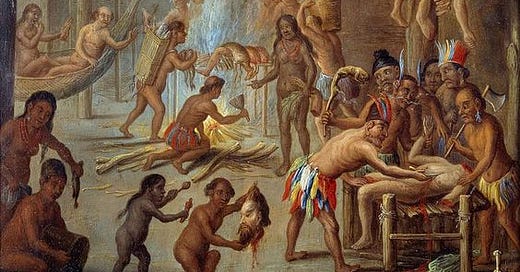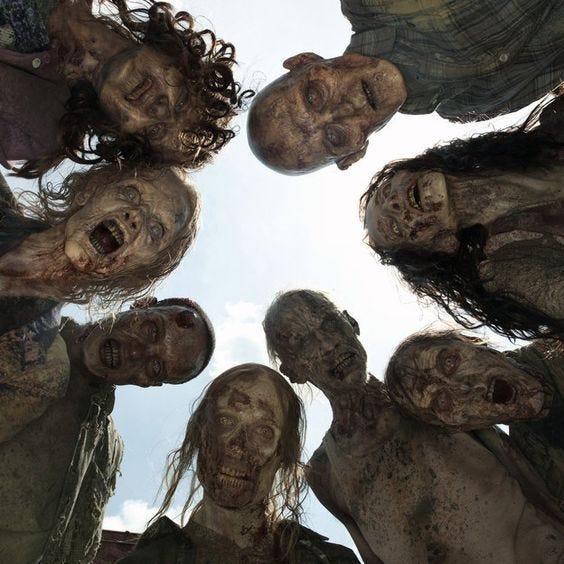Reader discretion is advised as cannibalism is a sensitive subject involving gore, death, and other forms of violence. This article will dive deep into its history and explore the connotations of romance hidden within this nature of behavior. This is an educational article and its author and written contents does not and will not support any form of discrimination or harassment of any communities or societies or individuals or groups of any kind of religious, sexual, or political- and the likes- groups.
When we used to think about cannibalism, the first thing that would pop into our head is: Hannibal, The Silence of the Lambs, Tender is the Flesh. A common theme between those is the horror genre, because the cannibalistic nature has always been portrayed as something more sinister, violent, defying the laws of human kind— An insatiable appetite for flesh and blood of humans.
The suffix ‘-vore’ has Latin roots, often translated to as: eating. Hence, carnivore, herbivore, etc.
History & Context
We may appropriately assume that cannibalism has stemmed from pop culture and various cult classic films, where vampires, zombies, and other supernatural creatures have begun to overtake our genre consumption since Night of The Living Dead. Zombies being one of the faces of cannibalistic society.
Apart from the notorious Meiwes-Brandes case in 2001 Germany that circled political waters with a question about consensual murder through cannibalism (essentially Vorarephilia), cannibalism was said to have historical evidences from almost 100,000 years ago, according to European historians. In a 2013 Smithsonian Magazine article entitled Europe’s Hypocritical History of Cannibalism, the bones and brains of Neanderthal bodies were said to have been missing when found in Moula-Gercy, a French cave. Not only that but thigh and tongue meat were said to have been extracted from the body as well.
“The cannibalism at Moula-Guercy wasn’t an isolated incident in prehistory. In the past two decades, researchers have reported other evidence that Neanderthals continued eating each other until just before their disappearance.” — Everts, S. (2013)
The most notable take from the article would be the mention of how cannibalism was heightened during a time of famine and need, so it leads to the bigger question of whether or not class struggle and poverty contributed to such a ‘crisis’ of cannibalistic nature.
“Part of the problem was that cannibalism at Ma’arra simply didn’t fit in with the European self-image. In medieval times, cultural enemies—not military or religious heroes—were commonly depicted as cannibals or giants, “especially in narratives of territorial invasion and conquest,” argues Geradine Heng, in Cannibalism, The First Crusade and the Genesis of Medieval Romance. “Witches, Jews, savages, Orientals, and pagans are conceivable as—indeed, must be—cannibals; but in the 12th-century medieval imaginary, the Christian European subject cannot.” — An excerpt from Smithsonian Magazine article by Sarah Everts
Pop Culture Icon: ZOMBIES
Zombies have grown to be one of the largest pop culture icons in the 21st century, creating hundreds of movies about this supernatural creature: An undead man that has a thirst for blood and brains. But, what is completely neglected by its fanatics is its historical significance, stemming from Haitian culture and African slavery.
Roots In Bondage
Despite Night of the Living Dead being the first American horror film to depict ‘Zombies, it didn’t identify its iconic antagonists to be as such. It was in the 1932 Bela Lugosi film "White Zombie” that culturally acknowledged the term. These sets of films, followed by Dawn of the Dead, Shaun of the Dead- A comedy-horror film (A personal favorite), as well as iZombie, World War Z, Zombieland (Another comedy-horror favorite), 28 Days Later, The Walking Dead, and a parody: Pride and Prejudice Zombies.
From comedy to horror to action-packed films and tv shows, Zombies have become a staple of the horror genre, but this ‘supernatural creature’ is actually rooted from Haiti in the 17th and 18th century during the French occupation, referring to the country as Saint-Dominique.
Further reading can be done through The Atlantic’s article by Mike Mariani, entitled “The Tragic, Forgotten History of Zombies”
Rooting from Haitian folklore, zombies are said to be the product of boko- a voudou sorcerer. Though it is of West African origin, it was brought over to Haiti by slaves. In Haiti, the slave labor was brutal and its slaves found *suicide* to be the only solution to escape from oppression.
“Death was the only real escape and seen as a way to return to Africa or lan Guinée (translated means Guinea)” — Gandh, 2013.
The concept of becoming a ‘zombie’ was what led to the hesitancy of slaves from taking their lives. A certain anecdote from the article had struck me about the lives of slaves during such a time.
“To become a zombie was the slave's worst nightmare: to be dead and still a slave, an eternal field hand.” — Gandh, 2013.
Further reading can be done through this article by Lakshmi Gandh, 2013. Zoinks! Tracing The History of ‘Zombie’ from Haiti To The CDC.
From such a tragic history to a concept that has turned romantic, cannibalism is a subject that is definitively sensitive. I find the cultural negligence of zombies and cannibalism to be astounding and how it transitioned from a horror genre to tragically romantic. Is it because of desensitization? To slavery? To death? To history? I have wondered what other pop culture icons have history that is just as tragic as the undead that has now become the face of cannibalism. How has cannibalism become so popular? And why? Is it a kink issue? Or something more sinister?
Meiwes-Brandes 2001
In 2001, Armin Meiwes decided to advertise a post on the internet for a “young well-built man, who wanted to be eaten” and Bernd Brandes replied with interest to the post. This fantastical desire of Meiwes had been lingering since the age of eight- As confessed during his court trial, where since young, he had always fantasized about ‘'killing and devouring someone’ with no exceptions. The meeting of Brandes had resulted into the victim (Brandes) swallowing dozens of sleeping tablets as well as half a bottle of Schnappa, a liqueur, and cutting off Brandes’ genitals before frying it for both of their consumption. The case escalated the next morning with Meiwes initiating the final blow by stabbing Brandes after kissing him first. All with prior consent from the victim.
“He tasted of pork.” — Armin Meiwes, 2003 Trial on Brandes’ alleged murder
For further reading of this case, it can be found at this The Guardian article by Luke Harding (2001) https://amp.theguardian.com/world/2003/dec/04/germany.lukeharding. The information provided in the paragraph above does not include grotesque details and claims from the article. Read at your own discretion.
Erotic Desire: To Eat or To Be Eaten?
This leads us to the concept of Vorarephilia. As stated earlier, it is the erotic desire to consume or to be consumed in a literal sense. Technically, it is a fetish, which would be a shocker to some when they find out that it exists pervasively in Children’s tales: Hansel and Gretel, Red Riding Hood, etc. The idea of wanting to eat another being whether creature or person falls under ‘Vore’, though this is stretched to a sexual intent.
This is not limited to human interactions but also has fantastical elements, so long as it involves the consumption of another or being consumed by another. From snakes to larger monsters.
The Meiwes-Branded 2001 case highlighted this sexual fantasy, where consuming Brandes was a form of arousal for Meiwes, which is why the perpetrator ended up with a 15-year sentencing after the first court trial, but because the defendant claimed that it was a consensual death [consent from the victim], it cannot be charged as manslaughter nor murder, but because of the sexual intent behind Brandes’ death, Meiwed still faced charges.
This was one of the first few casesin Germany that quirked the political waters due to the loophole that Meiwes and his party had found in order to avoid further charges, where it stretched from psychosis to further allegations as to why Meiwes had behaved in such a way.
For further reading of the 2003 article entitled Cannibal Case Grips Germany by Peter Finn of the Washington Post.
Hannibal Lecter: Sex Symbol Status
Since when did gore become sexy? I would like to claim that the desensitization of blood and guts in modern media is to blame, enabling the normalization of those types of content for viewers at a young age. Though I am not discriminating against viewers who enjoy such content, but we have to acknowledge that cannibalism has become something that is widely accepted as a romantic gesture from sexual to platonic, it is now a form of expression of love and affection. It is just interesting to me how it became a tragic symbol of slavery and death to sexual intent and just romantic.
To eat is to consume. To consume is to be. To be is to fantasize.
I find cannibalism in a literary sense as beautiful as it is terrifying, where intent is beyond feelings but can be turned to action. Overall, whether a kink or fetish or just downright nasty, vorarephilia is definitely as interesting as it is challengingly weird to comprehend.
There have been major forms of media that has covered cannibalism one way or another: Jennifer’s Body. To consume another person because our intent cannot capture the longing of our hearts.
Media Recommendations
I was able to survey my Book-Instagram following of the various shows, books, and movies that has cannibalism included!
Fresh (2022) by Mimi Cave
Hannibal (2001) by Adam Kane
Raw (2016) by Julia Ducournau
Wrong Turn (2021) by Mike P. Nelson
Tokyo Ghoul (2017) by Kentaro Hagiwara
Yellowjackets (2021) by Karyn Kusama
Santa Clarita Diet (2017) by Victor Fresco
A Certain Hunger (2019) by Chelsea G. Summers
Juniper & Thorn (2022) by Ava Reid
Earthlings (2018) by Sayaka Murata







![r/BattlePaintings - Haitian slaves fighting French troops [January Suchodolski] r/BattlePaintings - Haitian slaves fighting French troops [January Suchodolski]](https://substackcdn.com/image/fetch/$s_!cJOQ!,w_1456,c_limit,f_auto,q_auto:good,fl_progressive:steep/https%3A%2F%2Fsubstack-post-media.s3.amazonaws.com%2Fpublic%2Fimages%2F21fcc063-a44a-4708-9302-fa1211311a29_640x513.jpeg)


What a fantastic piece!!!